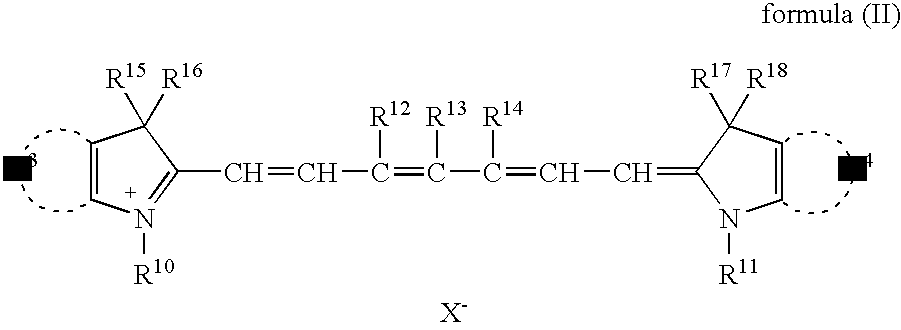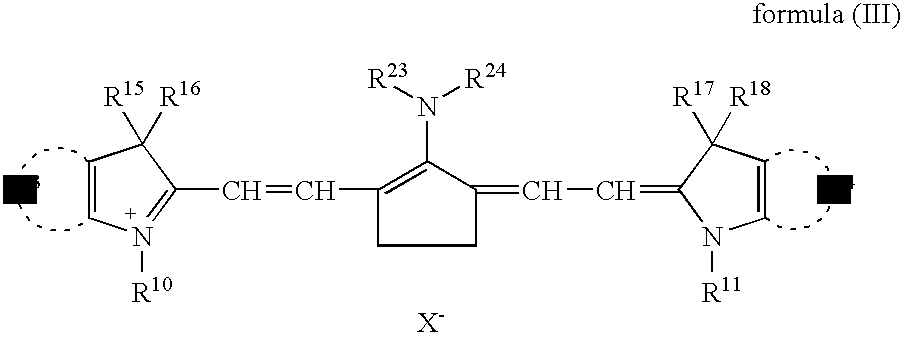Silver salt photothermographic dry imaging material
a technology of photothermographic and silver salt, applied in the field of silver salt photothermographic dry imaging material, can solve the problems of reduced sensitivity, reduced sensitivity, reduced sensitivity, and reduced sensitivity, so as to reduce fogging, enhance sensitivity, and enhance maximum density
- Summary
- Abstract
- Description
- Claims
- Application Information
AI Technical Summary
Benefits of technology
Problems solved by technology
Method used
Image
Examples
synthesis example 1
Synthesis of Exemplified Compound 2
[0026]A mixture of 11.4 g of 1,2,3,3-tetramethyl-5-indolenium-p-toluesulfonate, 7.2 g of N-(2,5-dianilinomethylenecyclopentylidene)-diphenylaluminium perchlorate, 100 ml of ethyl alcohol and 12 ml of acetic anhydride were stirred at an external temperature of 100° C. for 1 hr and precipitated crystals were filtered off. Subsequently, recrystallization was carried out in 100 ml of methyl alcohol to obtain 7.3 g of compound 2. It was proved that according to the conventional measurements, the melting point was not less than 270° C., λmax was 800.8 nm, and (molar extinction coefficient) was 2.14×105 (in chloroform).
[0027]Other exemplified compounds can also be synthesized in a manner similar to the foregoing.
[0028]Dyes usable I his invention include a squalilium dye containing a thiopyrylium nucleus, a squalilium dye containing a pyrylium nucleus, and a thiopyrylium croconium dye and pyryliumcroconium dye similar to a squalilium dye. A compound contai...
example 1
Preparation of Photothermographic Material
[0383]A photographic support comprised of a 175 μm thick biaxially oriented polyethylene terephthalate film with blue tinted at an optical density of 0.170 (determined by Densitometer PDA-65, manufactured by Konica Corp.), which had been subjected to corona discharge treatment of 8 W·minute / m2 on both sides, was subjected to subbing. Namely, subbing liquid coating composition a-1 was applied onto one side of the above photographic support at 22° C. and 100 m / minute to result in a dried layer thickness of 0.2 μm and dried at 140° C., whereby a subbing layer on the image forming layer side (designated as Subbing Layer A-1) was formed. Further, subbing liquid coating composition b-1 described below was applied, as a backing layer subbing layer, onto the opposite side at 22° C. and 100 m / minute to result in a dried layer thickness of 0.12 μm and dried at 140° C. An electrically conductive subbing layer (designated as subbing lower layer B-1), wh...
example 2
[0453]Photothermographic material samples 201 to 207 were prepared similarly to photothermographic material sample 101 to 107 of Example 1, provided that silver halide emulsions used in the light-sensitive layer coating compositions were chemically sensitized in the following manner.
[0454]While stirring, 50 g of the foregoing light-sensitive emulsion A of Example 1 and 15.11 g of MEK were mixed and the resultant mixture was maintained at 21° C. Subsequently, 390 μl of antifoggant 1 (10 percent methanol solution) was added and stirred for one hour. Then, 240 ml of sulfur sensitizer S-4 (10% methanol solution) was added thereto and stirred at 21° C. for 1 hr. to perform chemical sensitization. Further, 494 μl of calcium bromide (10 percent methanol solution) was added and stirred for 20 minutes. Subsequently, 167 ml of aforesaid stabilizer solution was added and stirred for 10 minutes. Thereafter, 1.32 g of aforesaid infrared sensitizing dye A was added and the resulting mixture was s...
PUM
 Login to View More
Login to View More Abstract
Description
Claims
Application Information
 Login to View More
Login to View More - R&D
- Intellectual Property
- Life Sciences
- Materials
- Tech Scout
- Unparalleled Data Quality
- Higher Quality Content
- 60% Fewer Hallucinations
Browse by: Latest US Patents, China's latest patents, Technical Efficacy Thesaurus, Application Domain, Technology Topic, Popular Technical Reports.
© 2025 PatSnap. All rights reserved.Legal|Privacy policy|Modern Slavery Act Transparency Statement|Sitemap|About US| Contact US: help@patsnap.com



